INTERVIEW
Surrey’s Premier Lifestyle Magazine
Humble hero
It’s 50 years since England became football World Cup champions when the players lived in a different age: all were humble professionals plying their trade. One of the rocks of that day was England’s right-back, George Cohen. David Lloyd talks to a very English hero.
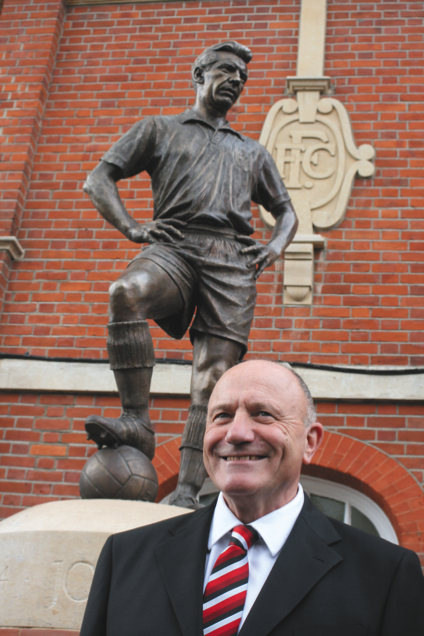
George Cohen in front of the statue of the great Johnny Haynes PHOTO COPYRIGHT: David Lloyd
A browse of the domestic sporting archives from 50 years ago reveals that Bill Shankly’s Liverpool won the First Division title and that Everton recovered from being 2-0 down against Sheffield Wednesday to lift the FA Cup. In cricket, the legendary Gary Sobers led his powerful West Indian side to a 3-1 Test series victory against England.
At Wimbledon, tennis aces Manuel Santana and Billie-Jean King claimed the singles’ titles, while over at Highbury, Henry Cooper succumbed in his rematch with World Heavyweight boxing champion Muhammad Ali in round six.
…Oh yes, and in the World Cup final at Wembley, England beat West Germany 4-2 after extra time to lift the Jules Rimet trophy.
Back in 1966, life in England seemed a lot less hectic – even with the nation gripped by World Cup final fever, and Alf Ramsey’s team about to create sporting history. It’s hard to believe today, but, on the eve of the biggest match of their career, the England team simply strolled down the road from their Hendon Hall Hotel to the local cinema, where they relaxed by watching British comedy ‘Those Magnificent Men in Their Flying Machines’. No troublesome paparazzi; no hordes of pesky autograph hunters; no unwanted interruptions.
Then, on the morning of the final, Bobby Charlton and Ray Wilson chose to amble around the nearby shops to pass the time and stretch their legs. They received several nods of recognition, but no one stopped them from going about their business. Similarly, one or two other players sauntered out for a cup of coffee, whereas the devout Nobby Stiles went to look for a Catholic church to pray and confess – in Golders Green!
For England’s right-back, George Cohen, the kick-off couldn’t come quickly enough. “Do you know, the butterflies set in as soon as I got up for breakfast,” he says.
“Generally I didn’t suffer from nerves at all – not even when I made my senior debut for Fulham against Liverpool at just 17 years of age.
“It wasn’t simply the magnitude of the Wembley final that got to me though, it was more that our regular pre-match preparations went right out of the window. The only consolation, I suppose, was that it was the same for both teams.”
If that stroll to the cinema was low-key, the short coach journey from Hendon to Wembley was anything but.
“The streets were jam-packed,” recalls Cohen. “It was quite a sight – so many people and flags everywhere! And it only underlined that we were carrying the hopes of so many people that afternoon.
“Once we’d got to Wembley, we were desperate to loosen up by doing our regular warm-ups and sprint exercises, but that was a no-no. Instead, we had all the ceremonial stuff, anthems and presentations.
At Wimbledon, tennis aces Manuel Santana and Billie-Jean King claimed the singles’ titles, while over at Highbury, Henry Cooper succumbed in his rematch with World Heavyweight boxing champion Muhammad Ali in round six.
…Oh yes, and in the World Cup final at Wembley, England beat West Germany 4-2 after extra time to lift the Jules Rimet trophy.
Back in 1966, life in England seemed a lot less hectic – even with the nation gripped by World Cup final fever, and Alf Ramsey’s team about to create sporting history. It’s hard to believe today, but, on the eve of the biggest match of their career, the England team simply strolled down the road from their Hendon Hall Hotel to the local cinema, where they relaxed by watching British comedy ‘Those Magnificent Men in Their Flying Machines’. No troublesome paparazzi; no hordes of pesky autograph hunters; no unwanted interruptions.
Then, on the morning of the final, Bobby Charlton and Ray Wilson chose to amble around the nearby shops to pass the time and stretch their legs. They received several nods of recognition, but no one stopped them from going about their business. Similarly, one or two other players sauntered out for a cup of coffee, whereas the devout Nobby Stiles went to look for a Catholic church to pray and confess – in Golders Green!
For England’s right-back, George Cohen, the kick-off couldn’t come quickly enough. “Do you know, the butterflies set in as soon as I got up for breakfast,” he says.
“Generally I didn’t suffer from nerves at all – not even when I made my senior debut for Fulham against Liverpool at just 17 years of age.
“It wasn’t simply the magnitude of the Wembley final that got to me though, it was more that our regular pre-match preparations went right out of the window. The only consolation, I suppose, was that it was the same for both teams.”
If that stroll to the cinema was low-key, the short coach journey from Hendon to Wembley was anything but.
“The streets were jam-packed,” recalls Cohen. “It was quite a sight – so many people and flags everywhere! And it only underlined that we were carrying the hopes of so many people that afternoon.
“Once we’d got to Wembley, we were desperate to loosen up by doing our regular warm-ups and sprint exercises, but that was a no-no. Instead, we had all the ceremonial stuff, anthems and presentations.
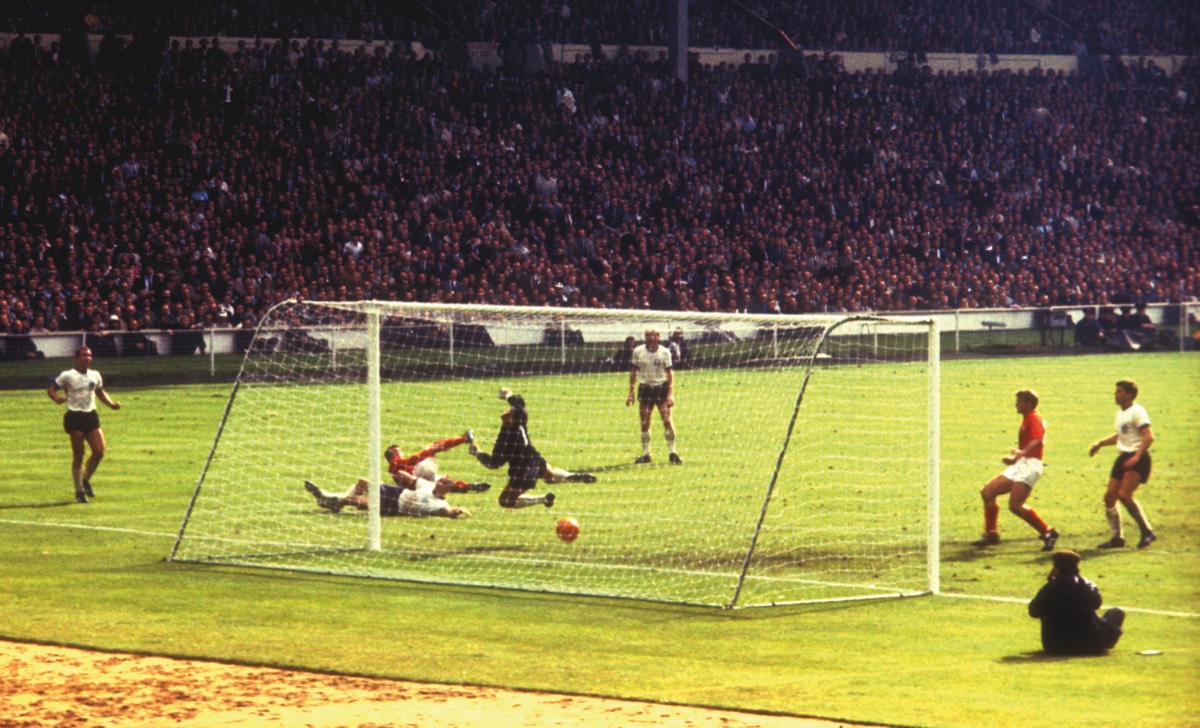
Geoff Hurst's hotly disputed second goal PHOTO COPYRIGHT: Ken Coton
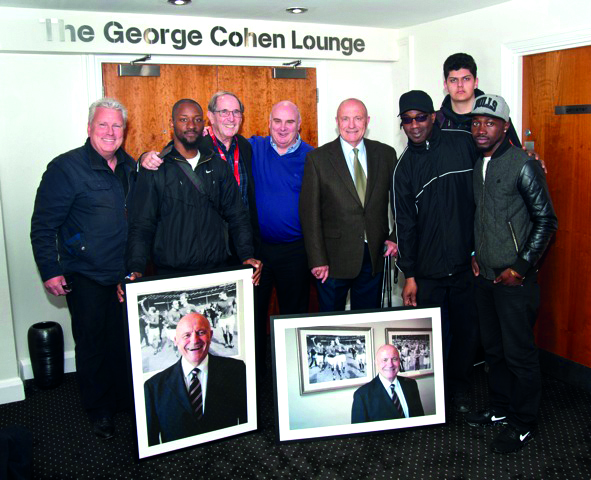
Members of the Wembley to Soweto group pictured with George Cohen (centre) and David Westhead (far left).
In the summer of 2010, actor/producer David Westhead of Wilton Pictures invited internationally renowned photographer John Cole to run a four-week photography course in Johannesburg, South Africa. The main thrust of the course, run in conjunction with Umuzi Photo Club, which works with young people in under-resourced communities, was how to use a camera to feed your family.The venture, which ran under the ‘Wembley to Soweto’ banner, has been a resounding success with participants not only learning how to take striking pictures, but also going on to gain full scholarships and bursaries to photographic colleges.
Earlier this season, Fulham FC opened its doors to a group of the young photographers on a matchday during which one of them chanced upon George Cohen in ‘his’ lounge. A group from the Wembley to Soweto enterprise paid George another surprise visit to his lounge recently, this time to present him with the results of that informal photoshoot in the form of two framed prints.
Thapelo Motsumi , who took one of the photographs and who is now a staff photographer for the Johannesburg Star, couldn’t make the presentation but sent a message from South Africa: “It’s not every day that we get the chance to capture legends from the sporting community. Mr Cohen, if we had had you in our line-up for the 2010 World Cup then South Africa would have done much better!”
Brazilian João Paulo Lima, who took the other photo of George, is now a teacher for the project. He’s all set to cover the Rio Olympics in August.
On receiving the prints, George said: “I’m really chuffed. In fact, I look very good in those photos – are you sure you didn’t use a younger model?”
Credits
John Cole/Wembley to Soweto Foundation
Thapelo Motsumi /Wembley to Soweto Foundation
João Paulo Lima/Wembley to Soweto Foundation
Below, the photo used by kind permission of Getty Images
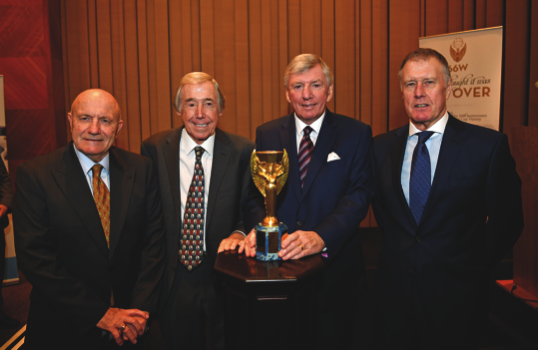
“The Royal Garden Hotel, London. 6 January 2016. Myself and fellow co-founder Chris Wilkins walk into the function room which 50 years to the day had hosted the draw for the 1966 World Cup. A huge bank of TV cameras lines the back of the room as the world's sports press take their seats and fill the room. Four legends George Cohen, Gordon Banks, Martin Peters and Sir Geoff Hurst were then reunited with the trophy in aid of the #memoriesof66 campaign supporting people living with dementia and also a programme to help prevent the onset of it. The following weekend George appeared on Radio 4's Saturday Live programme to speak about the #memoriesof66 campaign and gave his backing to the work of sporting memories.” Tony Jameson-Allen - co-founder, Sporting Memories Foundation
“When we walked down the tunnel and out onto the famous spongy turf, the noise was unbelievable – what a reception! As we lined up, I could sense that I wasn’t the only member of our team who was anxious. I remember saying to myself, ‘Don’t bugger this up now, George.’ With that, I prepared to meet the Queen.”
England’s path to the World Cup final had not been without incident – or controversy – although a drab 0-0 draw against Uruguay in the tournament’s curtain-raiser hardly set the pulses racing.
“The Uruguayans barely came out of their area,” says George, still showing signs of frustration five decades later, “so it developed into a dreary stalemate. We earned a useful point, but the crowd weren’t best pleased that we couldn’t break them down.
“Bobby Charlton’s fantastic goal against Mexico was the first real stand-out moment, a proper game-changer. After carrying the ball from his own half, he smacked a right-footer from about 25 yards that whistled into the net. Do you know, the ball seemed to be egg-shaped as it rocketed beyond their goalkeeper.
That exhilarating moment lifted the whole place, as well as our outlook; we never played badly after that.”
A brace of 2-0 victories – against Mexico and France – took England to the top of their group and through to a potentially tricky quarter-final encounter with Argentina.
“They were a good team, stacked with good players with great technical ability,” admits George. “Such a shame they resorted to those stupid, unsavoury tactics on the day – with their captain Rattin at the heart of it all. If I’d wanted to see one player sent off, it was him. He was that influential.”
Having already been booked for a foul on Bobby Charlton, Antonio Rattin was dismissed (no red cards in those days) in the 35th-minute and, incensed, he refused to leave the field, causing an eight-minute delay. Amid further unsavoury gamesmanship, shirt-pulling and spitting, a 78th-minute header from Geoff Hurst, in for the injured Jimmy Greaves, settled matters.
And yet that was far from the end of it. In the post-match press interviews Alf Ramsey suggested that: “the behaviour of some players in the competition reminds me of animals.”
Elsewhere, the great Pelé had been subjected to a rash of cynical fouls and was brutally kicked out of the tournament, but the Argentinians were in no doubt that Ramsey was referring specifically to them. His case wasn’t helped by what happened at the final whistle.
“Inadvertently, I became world famous!” recalls George. “Alf was livid with the way they’d approached that game and, looking back, it’s amazing we escaped with no serious injuries. When the final whistle went I agreed to swap shirts with Alberto Gonzalez, but Alf was having none of it – he raced onto the pitch to intervene, grabbing the shirt and pulling it back with force. As a consequence I had a shirt with a four-foot-long sleeve! That image went all around the globe.”
Portugal, and the brilliant Eusébio, were next. The winners would be in the final. “Eusébio, what a player, and what an athlete!” acknowledges George. “And that match turned out to be one of the best of the competition. We had our own brilliant matchwinner in Bobby Charlton, who scored both our goals, but Nobby’s performance that day was outstanding.
“Eusébio was one of the world greats, powerful and very quick. But Nobby, much smaller and way slower, shackled him. Eusébio’s input became limited to taking dead-ball kicks, including that late penalty from which he scored. Poor Eusébio left the pitch in tears as he’d not been allowed to contribute in the way he wanted because of Nobby’s brilliant man-marking job.”
The final against West Germany has gone down in football folklore. England 2-1 ahead only for the Germans to level seconds from the final whistle. Ramsey’s brief team-talk before extra time was magnificent.
“He told us to look over at the leg-weary Germans,” recalls George. “We were shattered too – Wembley was an energy-sapping surface – but Alf was having none of it. He told us to go for them from the restart, harry them, not to let them settle. His famous line was ‘Go out and win it again!’ – a lot easier said than done. However, it was a defining moment; and we did it!”
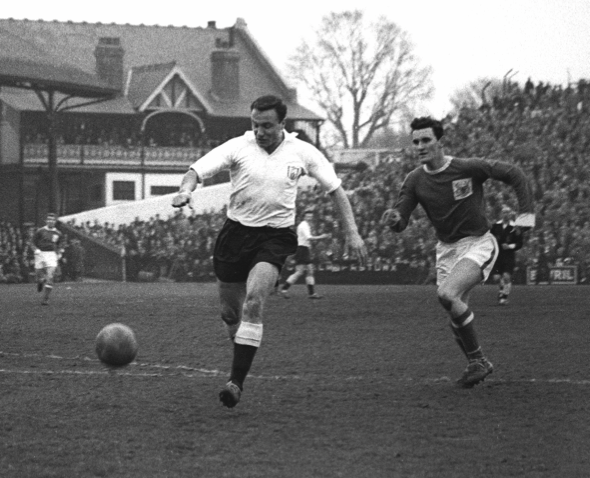
Cohen & Cottage, 3 March 1962, v Nottm Forest PHOTO COPYRIGHT: Ken Coton
Key memories of that Wembley final include:
• Martin Peters putting England 2-1 ahead;
• Wolfgang Weber’s 90th-minute leveller;
• Geoff Hurst’s hat-trick, including that dubious second goal;
• the ‘Russian’ linesman who awarded the goal (he was actually from Azerbaijan);
• Kenneth Wolstenholme’s renowned TV commentary: “Some people are on the pitch… they think it’s all over…it is now!” as Hurst’s third (England’s fourth) thumped into the net;
• the scenes at the final whistle – Alan Ball leaping onto Geoff Hurst’s shoulders, Jack Charlton sinking to the floor, delighted yet utterly exhausted, while his brother Bobby, overcome, couldn’t hold back the tears;
• captain Bobby Moore respectfully wiping his hands on the velvet drape so as not to soil the Queen’s white gloves on collecting the Jules Rimet trophy;
• Nobby Stiles’ victory jig on the Wembley turf while clutching the trophy;
• the iconic image of Moore, with trophy, on the shoulders of his team-mates.
“Frankly, I just remember being incredibly knackered – that and getting a big, open-mouthed kiss from Nobby at the final whistle,” says George, first with a grimace, then a broad smile. “Ugh, it was like being kissed by Mick Jagger! Best player on the park, though, was Alan Ball. He was magnificent and never stopped running for the whole 120 minutes. He was just a little kid at the time, but he stuck to his task brilliantly. To have Alan and Nobby performing so selflessly in and around my position was the stuff of dreams.
“We were certainly good enough to win the tournament, just as Alf told us we would. We had so many strong characters in our side, a strong team ethic, a top manager and more than a smattering of class – Ray Wilson, what a left-back; Bobby Moore, a majestic centre-back and super-cool captain; Bobby Charlton, fantastic and equally adept with either foot; plus we had the brilliant Gordon Banks in goal, don’t forget.”
Half a century later, those English footballing heroes remain the only eleven players to have won the World Cup. And, as any Fulham fan will tell you, England only win the World Cup with a Fulham player in the team.
In March 2016, Fulham FC announced that to mark George Cohen’s loyalty to the club, and to celebrate the 50th anniversary of his contribution to England’s World Cup win, they would not only be unveiling a statue of their former full-back in October, but that two men’s health initiatives would be launched in his name too.
The statue will be the work of esteemed sculptor Douglas Jennings who was responsible for the remarkable likeness of former Fulham and England captain Johnny Haynes, unveiled outside Craven Cottage in October 2008.
George, who played 459 times for the Whites, many alongside Haynes, as well as 37 times for his country, remains at the club today. On matchdays he is host of his own George Cohen Lounge where he delights those present with anecdotes from his playing days and analysis of Fulham’s most recent matches.
In late 2014, Fulham fan Ed Vanson recognised that the 50-year anniversary was on the horizon and canvassed several influential supporters of the club with the idea of comm-emorating George’s footballing achievements. By the start of 2015 a working group was in place.
• Martin Peters putting England 2-1 ahead;
• Wolfgang Weber’s 90th-minute leveller;
• Geoff Hurst’s hat-trick, including that dubious second goal;
• the ‘Russian’ linesman who awarded the goal (he was actually from Azerbaijan);
• Kenneth Wolstenholme’s renowned TV commentary: “Some people are on the pitch… they think it’s all over…it is now!” as Hurst’s third (England’s fourth) thumped into the net;
• the scenes at the final whistle – Alan Ball leaping onto Geoff Hurst’s shoulders, Jack Charlton sinking to the floor, delighted yet utterly exhausted, while his brother Bobby, overcome, couldn’t hold back the tears;
• captain Bobby Moore respectfully wiping his hands on the velvet drape so as not to soil the Queen’s white gloves on collecting the Jules Rimet trophy;
• Nobby Stiles’ victory jig on the Wembley turf while clutching the trophy;
• the iconic image of Moore, with trophy, on the shoulders of his team-mates.
“Frankly, I just remember being incredibly knackered – that and getting a big, open-mouthed kiss from Nobby at the final whistle,” says George, first with a grimace, then a broad smile. “Ugh, it was like being kissed by Mick Jagger! Best player on the park, though, was Alan Ball. He was magnificent and never stopped running for the whole 120 minutes. He was just a little kid at the time, but he stuck to his task brilliantly. To have Alan and Nobby performing so selflessly in and around my position was the stuff of dreams.
“We were certainly good enough to win the tournament, just as Alf told us we would. We had so many strong characters in our side, a strong team ethic, a top manager and more than a smattering of class – Ray Wilson, what a left-back; Bobby Moore, a majestic centre-back and super-cool captain; Bobby Charlton, fantastic and equally adept with either foot; plus we had the brilliant Gordon Banks in goal, don’t forget.”
Half a century later, those English footballing heroes remain the only eleven players to have won the World Cup. And, as any Fulham fan will tell you, England only win the World Cup with a Fulham player in the team.
In March 2016, Fulham FC announced that to mark George Cohen’s loyalty to the club, and to celebrate the 50th anniversary of his contribution to England’s World Cup win, they would not only be unveiling a statue of their former full-back in October, but that two men’s health initiatives would be launched in his name too.
The statue will be the work of esteemed sculptor Douglas Jennings who was responsible for the remarkable likeness of former Fulham and England captain Johnny Haynes, unveiled outside Craven Cottage in October 2008.
George, who played 459 times for the Whites, many alongside Haynes, as well as 37 times for his country, remains at the club today. On matchdays he is host of his own George Cohen Lounge where he delights those present with anecdotes from his playing days and analysis of Fulham’s most recent matches.
In late 2014, Fulham fan Ed Vanson recognised that the 50-year anniversary was on the horizon and canvassed several influential supporters of the club with the idea of comm-emorating George’s footballing achievements. By the start of 2015 a working group was in place.
England 1966 factfile:
England World Cup results 1966(all at Wembley Stadium)
11 July 1966 • Group 1 • England 0 Uruguay 0
England: Gordon Banks, George Cohen, Ray Wilson, Nobby Stiles, Jack Charlton, Bobby Moore, Alan Ball, Jimmy Greaves, Bobby Charlton, John Connelly, Roger Hunt.
16 July 1966 • Group 1 • England 2 Mexico 0
England: Gordon Banks, George Cohen, Ray Wilson, Nobby Stiles, Jack Charlton, Bobby Moore, Jimmy Greaves, Bobby Charlton, Martin Peters, Terry Paine, Roger Hunt.
Goals: Bobby Charlton (37 min); Roger Hunt (75 min)
20 July 1966 • Group 1 • England 2 France 0
England: Gordon Banks, George Cohen, Ray Wilson, Nobby Stiles, Jack Charlton, Bobby Moore, Jimmy Greaves, Bobby Charlton, Martin Peters, Ian Callaghan, Roger Hunt.
Goals: Roger Hunt (38 & 75 mins)
23 July 1966 • Quarter-Final • England 1 Argentina 0
England: Gordon Banks, George Cohen, Ray Wilson, Nobby Stiles, Jack Charlton, Bobby Moore, Alan
Ball, Bobby Charlton, Geoff Hurst, Martin Peters, Roger Hunt.
Goal: Geoff Hurst (78 min)
25 July 1966 • Semi-Final • England 2 Portugal 1
England: Gordon Banks, George Cohen, Ray Wilson, Nobby Stiles, Jack Charlton, Bobby Moore, Alan Ball, Bobby Charlton, Geoff Hurst, Martin Peters,
Roger Hunt.
Goals: Bobby Charlton (30 & 80 mins); Eusébio
(82 min) (Pen)
30 July 1966 • Final • England 4 West Germany 2 (aet)
England: Gordon Banks, George Cohen, Ray Wilson, Nobby Stiles, Jack Charlton, Bobby Moore, Alan Ball, Bobby Charlton, Geoff Hurst, Martin Peters,
Roger Hunt.
Goals: Helmut Haller (12 min); Geoff Hurst (18 min); Martin Peters (78 min); Wolfgang Weber (89 min); Geoff Hurst (101 & 120 mins)
“In essence, we were just a group of fans who were determined to see George honoured in some way,” explains Ed. “Of course, once the group got together the enormity of our task struck home. We soon agreed that a Douglas Jennings’ statue was our preferred option, along with some sort of legacy that revolved around George’s work in the community, but these things don’t come cheap – the ballpark figure was £100,000 – and there was an enormous amount of work ahead of us.”
It took a while for the club to sanction the project; when they did, they took over the reins – and Fulham Chairman Shahid Khan promptly pledged to match, pound for pound, whatever sum was raised by supporters to not only ensure the statue is erected, but also so that the Fulham FC Foundation can deliver the health initiatives supported by George.
On being told of the plans, George Cohen, humble as ever, could only remark that he was “completely gobsmacked”.
To contribute, please visit: www.tifosy.com /en/campaigns/thank-you-to-fulham-1966-world-cup-legend-george-cohen.
Before heading off to the Euros, England manager Roy Hodgson (and Fulham boss from December 2007 to July 2010) said of George Cohen: “I remember watching the 1966 World Cup final at home in Croydon. It’s been great to subsequently meet and get to know George. He’s an iconic legendary figure as far as English football is concerned.
“He’s a genuine, decent man and someone who, despite his great success, has very much kept his feet on the ground while retaining his enthusiasm for football and the club as the sport has evolved.
“He maintains a keen interest in the modern game without wishing to denigrate today’s players (or today’s Fulham) by referring back to what was, after all, his crowning achievement as a World Cup winner almost 50 years ago.
“George remains not only a sporting hero, but a real gentleman too.”
To this day only 11 players plus one manager have won the football World Cup for England. However, the passage of time sadly means that not all 12 are still around to celebrate the golden anniversary of that magnificent achievement.
Captain Bobby Moore succumbed to bowel cancer in 1993, aged just 51. Manager Sir Alf Ramsey – he was knighted in 1967 – passed away in 1999, aged 79, then Alan Ball (61) suffered a fatal heart attack in 2007.
Several others are unwell. Among them, Nobby Stiles, Ray Wilson and Martin Peters have been diagnosed with Alzheimer’s, while Jack Charlton is suffering memory-loss problems.
Indeed, for George Cohen, even winning the World Cup has turned out to be the easy bit – he’s had to recover from the sudden loss of his mother, killed by a juggernaut in Fulham in 1971, and then having to identify her body. In 2000 younger brother Peter was brutally attacked by a group of men outside a nightclub in Northampton. Peter, father of World Cup-winning rugby union star Ben Cohen, died a month later in hospital.
George has beaten cancer three times, finally getting the all-clear in 1990. “I had my first diagnosis in 1976. Then 18 months later the cancer returned. I had to have another major operation – 10 weeks in hospital, and a colostomy. Not the ideal scenario at 38 years of age,” says George with remarkable understatement.
“Another 18 months down the line it was back in my pelvis. I had to have chemotherapy and radiotherapy, but finally got the all-clear. For someone who was always known for my fitness and strength, it’s frustrating to have mobility problems these days but, hey, I’m lucky to be here at all. I’m also extremely fortunate in having a wonderful, loving, and oh-so-strong wife in Daphne who has been marvellous throughout all the trials and tribulations.”
George was forced to hang up his boots following a freak injury in a match against Liverpool in December 1967. He was 29, at the peak of fitness and it was only 18 months after winning the World Cup.
“No collision, no opponent involved,”
says George. “In trying to control an awkward bouncing ball I put too much pressure on my left knee and, ouch, the pain was immediate and intense. Over the next year or so I had two cartilage operations, but it was no good; career over.”
It took a while for the club to sanction the project; when they did, they took over the reins – and Fulham Chairman Shahid Khan promptly pledged to match, pound for pound, whatever sum was raised by supporters to not only ensure the statue is erected, but also so that the Fulham FC Foundation can deliver the health initiatives supported by George.
On being told of the plans, George Cohen, humble as ever, could only remark that he was “completely gobsmacked”.
To contribute, please visit: www.tifosy.com /en/campaigns/thank-you-to-fulham-1966-world-cup-legend-george-cohen.
Before heading off to the Euros, England manager Roy Hodgson (and Fulham boss from December 2007 to July 2010) said of George Cohen: “I remember watching the 1966 World Cup final at home in Croydon. It’s been great to subsequently meet and get to know George. He’s an iconic legendary figure as far as English football is concerned.
“He’s a genuine, decent man and someone who, despite his great success, has very much kept his feet on the ground while retaining his enthusiasm for football and the club as the sport has evolved.
“He maintains a keen interest in the modern game without wishing to denigrate today’s players (or today’s Fulham) by referring back to what was, after all, his crowning achievement as a World Cup winner almost 50 years ago.
“George remains not only a sporting hero, but a real gentleman too.”
To this day only 11 players plus one manager have won the football World Cup for England. However, the passage of time sadly means that not all 12 are still around to celebrate the golden anniversary of that magnificent achievement.
Captain Bobby Moore succumbed to bowel cancer in 1993, aged just 51. Manager Sir Alf Ramsey – he was knighted in 1967 – passed away in 1999, aged 79, then Alan Ball (61) suffered a fatal heart attack in 2007.
Several others are unwell. Among them, Nobby Stiles, Ray Wilson and Martin Peters have been diagnosed with Alzheimer’s, while Jack Charlton is suffering memory-loss problems.
Indeed, for George Cohen, even winning the World Cup has turned out to be the easy bit – he’s had to recover from the sudden loss of his mother, killed by a juggernaut in Fulham in 1971, and then having to identify her body. In 2000 younger brother Peter was brutally attacked by a group of men outside a nightclub in Northampton. Peter, father of World Cup-winning rugby union star Ben Cohen, died a month later in hospital.
George has beaten cancer three times, finally getting the all-clear in 1990. “I had my first diagnosis in 1976. Then 18 months later the cancer returned. I had to have another major operation – 10 weeks in hospital, and a colostomy. Not the ideal scenario at 38 years of age,” says George with remarkable understatement.
“Another 18 months down the line it was back in my pelvis. I had to have chemotherapy and radiotherapy, but finally got the all-clear. For someone who was always known for my fitness and strength, it’s frustrating to have mobility problems these days but, hey, I’m lucky to be here at all. I’m also extremely fortunate in having a wonderful, loving, and oh-so-strong wife in Daphne who has been marvellous throughout all the trials and tribulations.”
George was forced to hang up his boots following a freak injury in a match against Liverpool in December 1967. He was 29, at the peak of fitness and it was only 18 months after winning the World Cup.
“No collision, no opponent involved,”
says George. “In trying to control an awkward bouncing ball I put too much pressure on my left knee and, ouch, the pain was immediate and intense. Over the next year or so I had two cartilage operations, but it was no good; career over.”
essence info
Exhibitions at Wembley & the National Football Museum is a joint project to capture the nation's memories of 1966 (www.memoriesof66.com) and an innovative project to support older fans and to help tackle dementia, depression and loneliness to be run by Sporting Memories in partnership with the FA & NFM.



